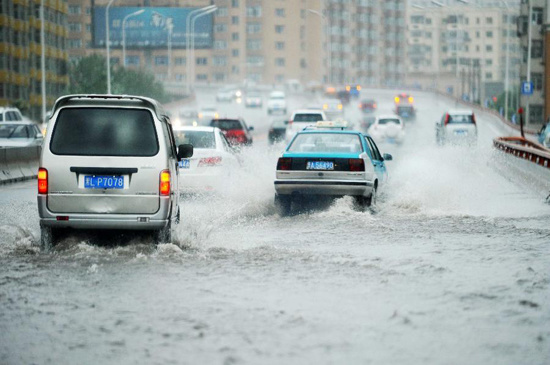
Vehicles move in rain on a flooded overpass in Harbin, capital of northeast China's Heilongjiang Province, July 29, 2012. (Photo: Xinhua)
(Ecns.cn) -- Heavy rains have hit parts of China over the past weeks, causing flash flooding and waterlogging. In some cities, the downpours cost lives, which has touched off doubts about the adequacy of the country's infrastructure construction plan, said Xinmin Weekly.
On July 21, Beijing sank under the heaviest rain in six decades, and remained waterlogged by an 170 mm of precipitation on average across the entire city and 225 mm in the urban center. The latest calculations put the storm's death toll at 77, most of those drowned in flooded areas.
Provinces such as Hebei, Heilongjiang, Shaanxi, Sichuan and Xinjiang have been confronted with the same problem, where waterlogging occurred within a very short period of time after heavy rain fall, affecting the safety and mobility of residents.
Basic infrastructure needs such as drainage systems have to be reassessed, as the underground drainage system meant to handle water run off is obviously not concurrent with city development, pointed out some experts.
Low standard of drainage networks
About 1.9 million people in 13 of Beijing's 16 districts and counties were affected by torrential rains on July 21, which also wreaked havoc to the tune of 11.64 billion yuan ($1.83 billion), revealed official statistics.
In fact, flooding is not something new to the capital. On June 23 of last year, after a heavy rain hit Beijing, traffic was swamped in many parts of the city, and scenes of a "subway waterfall" and "sea on the second-ring road" became the source of popular public jokes.
Wide discussion has resulted in a focus on improvement of drainage systems.
According to Li Na, senior engineer of the China Institute of Water Resources and Hydropower Research, Beijing's drainage networks were designed to prevent floods for rainfalls less than 45mm per hour, which is a once-in-three-year occurance.
But in some parts of the city, the drainage systems cannot even handle floods for rainfalls over 30mm per hour, admitted Li.
Some of the discharge pipe network facilities were designed according to standards made in the 1960s and 1970s, said Dou Yisong, a professor at the China Institute of Water Resources and Hydropower Research.
As a result of urbanization, the topology, terrain, and water convergence conditions in urban areas have been altered, and large proportions of land have been changed into impervious areas, therefore ground water holding capacity is greatly reduced.
Under such conditions, low-standard facilities are insufficient, added Dou.
Immature alert system
In 2004, Beijing created a disaster alert system in 2004 after an unexpected rainstorm stalled the city's traffic, and since then, the Beijing Meteorological Bureau has run a text message service to mobile phone users informing them of impending extreme weather conditions, according to Global Times.
However, prior to the rain on July 21, very few Beijing residents received these weather emergency alerts, and the affected people later fingered the ineffectiveness of the service.
Cheng Xiaotao, vice chief engineer at the China Institute of Water Resources and Hydropower Research, told Xinmin Weekly that Beijing has made many improvements to the disaster prevention mechanism, and the government has mobilized all sectors to assist in rescue operations, including the media, police and health institutions.
The government has learned some lessons from the past few years' experience, but this rainfall activity was quite unexpected and the consequences went beyond imagination, said Cheng.
Global Times pointed out the drainage facilities group had been overly confident about their plans this time, as the heavy downpour overwhelmed the capacity of sewage tunnels soon after the rain began.
This torrential rain was itself a natural disaster, which had a stronger impact than expected, but one has to admit that even the cities with drainage networks designed for rainfalls of once-in-ten-year nature may have been caught off guard, added Cheng.
Calls to strengthen preventive actions
Waterlogging has been a civic woe in recent years, with urban areas more and more vulnerable to flooding as rapid modernization leaves ground water holding capacity an afterthought.
To make preparations for possible urban flooding, it is imperative that drainage systems be upgraded with advanced technology to ensure cities meet new standards. This is fundamental to the prevention of natural disasters, pointed out some experts.
Meanwhile, the government should intensify efforts in forecasting for urban rainstorms and early-warning systems for waterlogging.

Copyright ©1999-2011 Chinanews.com. All rights reserved.
Reproduction in whole or in part without permission is prohibited.